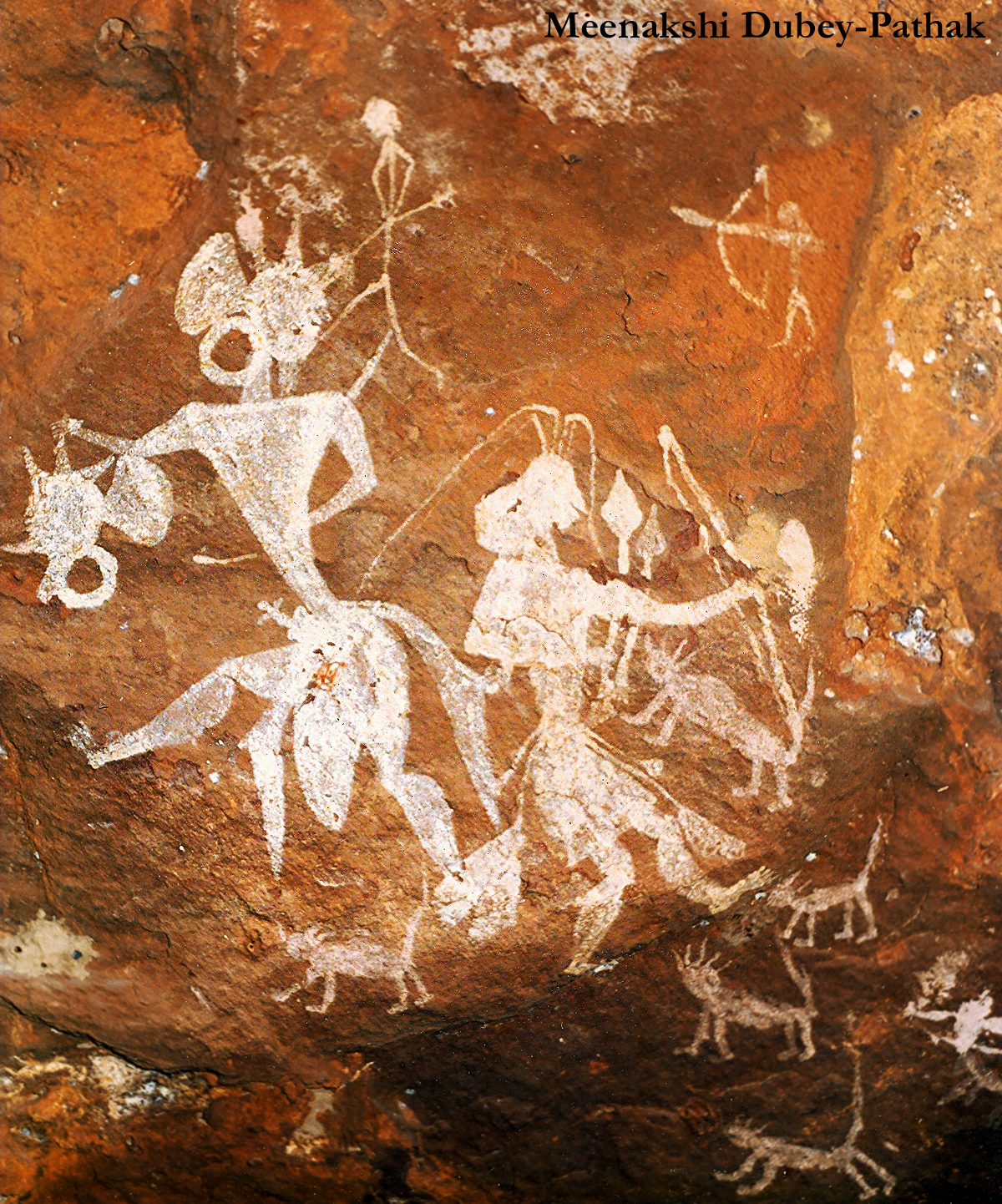


Meenakshi Dubey-Pathak discovers some of the less common themes in Indian rock art.
Pachmarhi is a complex of hills, waterfalls, caves and shelters, which has made subsistence possible and secure for human beings for many thousands of years. The rock paintings of this area are known to extend from the Mesolithic to the Historic period.

During my PhD research work (field work 1986 to 1991) I have found several depictions of headhunters holding severed heads in the rock paintings of the Pachmarhi Hills. It is not a common theme.
The tradition of human sacrifice to appease the gods and goddesses has been documented among Indian tribes, particularly the Gonds, Sauras and Korkus. Human sacrifice used to be performed by tribes in the Mahadeo Hills until as late as the 19th century. For example, in 1822 a European officer (Forsyth 1989 : 180-4) witnessed the sacrifice of a visitor made at the Kal Bhairav shrine. Bhairav is one of the many names of Lord Shiva. In India shrines to Shiva are the oldest and most famous of all. Forsyth (1989:179) also describes a scene where he witnessed devotees hurling themselves off a cliff, obviously offering their lives to Lord Shiva.
Headhunters of Pachmarhi rock art #India #RockArt #paintingshttps://t.co/rlZ8c7uxjf pic.twitter.com/E7iUIL8NYS
— Bradshaw Foundation (@BradshawFND) August 31, 2016
The rock paintings provide further evidence of human sacrifice. These depictions - all almost identical - have been found only in four shelters of the Pachmarhi area.
I am of the view that warring factions be-headed the vanquished enemy and carried away the heads as war trophies to show the folk who had stayed behind. There are scenes showing a man holding a human head in one hand and a weapon in the other, and he seems to be running away and looking backwards, giving the impression that he is being chased by the enemy. Such depictions of head hunting are prominent in the shelter located in Langi Nadi hill.
The rock shelter at Barkachar (locally called Swem Aam) also contains a pictograph of headhunting. This figure is 30 x 30 cms. Another shelter depicting headhunting is known as Nagdwari situated approximately 35 km from Pachmarhi town. The paintings in this shelter are similar in style to those found at Swem Aam and Langi Nadi.
The highest number of figures of headhunters have been found in the rock shelter at Rajat Prapat. These paintings show three men each holding a head while running in the same direction and looking back over their shoulders.
It is interesting to note that all the four paintings pertaining to headhunters are in-filled with white and outlined in red. All the figures have sharp features and are well proportioned. The men wear some form of head gear, earrings and a loin cloth. The severed head is held in the right hand and a sword in the left hand. It is remarkable that all the headhunters are shown escaping or running in the same direction, i.e. from right to left and are looking backwards over their shoulder. All the severed heads have head gear, earrings and necklaces similar to those of the headhunters.
It would not be out of context to mention incidents of headhunting amongst groups in conflict. The Nocte and Wanchu tribes in North Eastern India used to behead their enemies and display the skulls as war trophies in their clubs (locally called Morangs). Some of these tribes wear brass replicas of the head (s) as pendants, to indicate that their ancestors were warriors and hunted a specific number of the enemy. A person wearing two pendants meant that his ancestor had beheaded two enemies, thus exhibiting the deeds of valour of the forefathers (Gazetteer of Arunachal Pradesh).
Meenakshi Dubey-Pathak
Ref: In 1991, 'The Head Hunters in the Rock Paintings of Pachmarhi Hills' Man and Environment V-XVI, No.2, International journal of ISPQS, Indian Society of Prehistory and Quaternary Studies, Deccan College Pune, now a Deemed University (pg no.81-85).
Images: Meenakshi Dubey-Pathak
Visit the Pachmarhi Hills Rock Paintings section:
by Bradshaw Foundation
Monday 30 May 2022
by Bradshaw Foundation
Wednesday 19 January 2022
by Bradshaw Foundation
Thursday 06 January 2022
by Bradshaw Foundation
Monday 06 December 2021
by Bradshaw Foundation
Monday 29 November 2021
by Bradshaw Foundation
Monday 25 October 2021
by Bradshaw Foundation
Monday 12 July 2021
by Bradshaw Foundation
Monday 24 May 2021
by Bradshaw Foundation
Tuesday 20 April 2021
by Bradshaw Foundation
Thursday 01 April 2021
by Bradshaw Foundation
Tuesday 23 February 2021
by Bradshaw Foundation
Thursday 14 January 2021
by Bradshaw Foundation
Friday 18 December 2020
by Bradshaw Foundation
Sunday 06 December 2020
by Bradshaw Foundation
Thursday 26 November 2020
by Bradshaw Foundation
Wednesday 07 October 2020
by Bradshaw Foundation
Monday 30 May 2022
by Bradshaw Foundation
Wednesday 19 January 2022
by Bradshaw Foundation
Thursday 06 January 2022
by Bradshaw Foundation
Monday 06 December 2021
by Bradshaw Foundation
Monday 29 November 2021
by Bradshaw Foundation
Monday 25 October 2021
by Bradshaw Foundation
Monday 12 July 2021
by Bradshaw Foundation
Monday 24 May 2021
by Bradshaw Foundation
Tuesday 20 April 2021
by Bradshaw Foundation
Thursday 01 April 2021
by Bradshaw Foundation
Tuesday 23 February 2021
by Bradshaw Foundation
Thursday 14 January 2021
by Bradshaw Foundation
Friday 18 December 2020
by Bradshaw Foundation
Sunday 06 December 2020
by Bradshaw Foundation
Thursday 26 November 2020
by Bradshaw Foundation
Wednesday 07 October 2020
Friend of the Foundation











